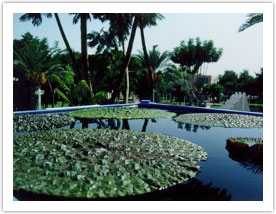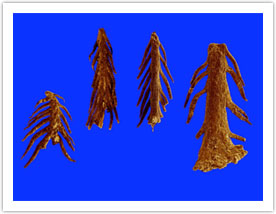Center of Excellence
Botany Research Sub-Group
Projects - Extinct and exotic plants
In the wet habitats near the lake in the wet habitats, the vegetation of the site differed from that of the pre-drainage Lake Hula, which was dominated by paper reed (Cyperus papyrus). The reconstructed wet vegetation, as revealed by the plant remains, includes totally extinct and regional extinct species, which occupied a wide range of wet habitats. Stratiotes intermedius, for example, is a fossil species that comprises an intermediate stage in the evolution between the extinct S. tuberculatus and S. aloides, the only species of this genus still existing today. The regionally extinct species include tropical-subtropical plants, such as prickly water lily (Euryale ferox) and Najas foveolata, as well as inhabitants of temperate regions, such as Nymphoides peltata, Potamogeton coloratus/polygonifolius and also species with boreal-tropical distribution, such as water chestnut (Trapa natans) and common arrow-head (Sagittaria sagittifolia). All species are immersed or floating freshwater plants.
E. ferox (prickly water lily) is a prickly aquatic perennial with a short thick rootstock. It has floating orbicular leaves measuring up to 1.5 m in diameter. Its flowers are usually submerged after self-pollination. The fruit is a spongy berry crowned with persistent sepals and covered with stout prickles. Each fruit contains 8–40 seeds, which measure up to 13 mm long and have a pulpy aril and hard thick testa (outer shell). The plant’s distribution area now includes tropical, subtropical, and temperate regions of eastern and southeastern Asia. It is found growing wild, for example, in India, Manchuria, and Hainan, China. The edible seeds are traded and exported in both raw and roasted form.
 |
|
Prickly water lily (Euryale ferox), which was recently grown in Bar-Ilan University
|
 |
|
Prickly water lily (Euryale ferox), ancient seed fragment with the typical hilum (SEM)
|
Trapa natans (water chestnut) is an aquatic annual that grows in stagnant or sluggish fresh water. Its long stems bear pectinate leaves under water and rhomboid rosulate leaves with swollen petioles on the water’s surface. The leaf rosettes cover large areas of their water habitat. Trapa’s fruit is a seeded nut, the water chestnut, which contains a starchy edible cotyledon and is covered with a smooth, thin, fleshy pericarp that undergoes maceration under water. This ‘‘nut’’ has woody projections (‘‘horns’’), with the sepals taking the form of barbed spines. People consume Trapa seeds both raw and cooked; in India, those who have access to water chestnuts eat them about 5 months of the year. The plant’s area of distribution is Asia, Africa, and central and southeastern Europe.
 |
|
Harpoons of water chestnut (Trapa natans). Sepal fragments from GBY. This aquatic plant grows today in temperate regions. The sepals take the form of long spines, each with typical retrorse barbs. Mammals and birds eat the nuts, and people consume them raw and cooked (SEM).
|
|